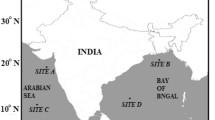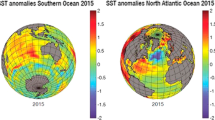Abstract
Surface temperature is one of the first ocean variables investigated. Ocean temperature is a key indicator of global climate change. The anomalies in ocean temperature have caused significant deterioration of marine systems. Existing works on surface temperature anomaly considered a suite of other remote sensing measurements such as wave height, salinity and models such as support vector machine, self-organizing maps and convolutional neural networks. Neural networks are used for predicting the surface temperature. This paper proposes use of long short-term memory, a recurrent neural network method to the estimate sea surface temperature anomalies based on previous year’s sea surface temperature anomalies. NOAA OI SST V2 dataset with 40 years of data is used in the experimentation. Auto-regression is used during data preprocessing. The basic LSTM method with 3 blocks of size 2 is enhanced to 50 neurons. This proposed LSTM model has been assessed for performance on time series data, yearly wise and for the entire dataset and found that the model has been able to predict the anomalies with a reasonably good precision. The model produced error of 0.036 indicating that the model is feasible for predicting the temperature anomaly and mean absolute error of 0.14 on the testing data.






Similar content being viewed by others
Availability of data and material
Data are available with INCOIS.
Code availability
Software application.
References
Hochreiter S, Schmidhuber J (1997) Long short-term memory, Neural Computation
Yuan X, Li L, Wang Y (2020) Nonlinear dynamic soft sensor modeling with supervised long short-term memory network. IEEE Trans Industr Inf 16(5):3168–3176. https://doi.org/10.1109/TII.2019.2902129
Haghbin M, Sharafati A, Motta D et al (2021) Applications of soft computing models for predicting sea surface temperature: a comprehensive review and assessment. Prog Earth Planet Sci 8:4. https://doi.org/10.1186/s40645-020-00400-9
Zhang Z, Pan X, Jiang T, Sui B, Liu C, Sun W (2020) Monthly and quarterly sea surface temperature prediction based on gated recurrent unit neural network. J Marine Sci Eng 8(4):249. https://doi.org/10.3390/jmse8040249
He Q, Zha C, Song W, Hao Z, Yu D, Liotta A, Perra C (2020) Improved particle swarm optimization for sea surface temperature prediction. Energies 13(6):1369. https://doi.org/10.3390/en13061369
Wang H, Song T, Zhu S, Yang S, Feng L (2021) Subsurface temperature estimation from sea surface data using neural network models in the western pacific ocean. Mathematics 9(8):852. https://doi.org/10.3390/math9080852
Zhou H, Zhang Y, Yang L, Liu Q, Yan K, Du Y (2019) Short-term photovoltaic power forecasting based on long short term memory neural network and attention mechanism. IEEE Access 7:78063–78074. https://doi.org/10.1109/ACCESS.2019.2923006
Abdullayeva G, Tkaczyk A, Meelis Kull N (2019) Application and evaluation of LSTM architectures for energy time-series forecasting Master's Thesis (30 ECTS) Application and Evaluation of LSTM Architectures for Energy Time-Series Forecasting
Cheng H, Sun L, Li J (2021) Neural network approach to retrieving ocean subsurface temperatures from surface parameters observed by satellites. Water 13(3):388. https://doi.org/10.3390/w13030388
Shao Q, Li W, Hou G, Han G, Wu X, Mid-term simultaneous spatiotemporal prediction of sea surface height anomaly and sea surface temperature using satellite data in the South China Sea. In: IEEE Geoscience and Remote Sensing Letters, https://doi.org/10.1109/LGRS.2020.3042179
Wei L, Guan L, Qu L, Guo D (2020) Prediction of sea surface temperature in the China seas based on long short-term memory neural networks. Remote Sens 12(17):2697. https://doi.org/10.3390/rs12172697
Sarkar PP, Janardhan P, Roy P (2020) Prediction of sea surface temperatures using deep learning neural networks. SN Appl Sci 2:1458. https://doi.org/10.1007/s42452-020-03239-3
Ratnam JV, Dijkstra HA, Behera SK (2020) A machine learning based prediction system for the Indian Ocean Dipole. Sci Rep 10:284. https://doi.org/10.1038/s41598-019-57162-8
Zhang H, Qian C (2020) Convergence analysis on inertial proportional delayed neural networks. Adv Differ Equ 2020:277. https://doi.org/10.1186/s13662-020-02737-3
Cao Q, Guo X (2020) Anti-periodic dynamics on high-order inertial Hopfield neural networks involving time-varying delays. AIMS Mathematics 5(6):5402–5421. https://doi.org/10.3934/math.2020347
Zhang H, Cao Q, Yang H (2020) Asymptotically almost periodic dynamics on delayed Nicholson-type system involving patch structure. J Inequal Appl 2020:102. https://doi.org/10.1186/s13660-020-02366-0
Sea Surface Temperature Anomaly, earth observatory, NASA, https://earthobservatory.nasa.gov/global-maps/AMSRE_SSTAn_M, last accessed on 05–06–2021
NOAA OI SST V2 High Resolution Dataset, Physical Sciences Laboratory, https://psl.noaa.gov/data/gridded/data.noaa.oisst.v2.highres.html, last accessed on 25-06-2021
Vasavi S, Priyadarshini NK, Vardhan KH (2020) Invariant Feature based Darknet Architecture for Moving Object classification. IEEE Sens J. https://doi.org/10.1109/JSEN.2020.3007883
Wu Y, Tang Y (2019) Seasonal predictability of the tropical Indian Ocean SST in the North American multimodel ensemble. Clim Dyn 53:3361–3372. https://doi.org/10.1007/s00382-019-04709-0
Funding
Not applicable.
Author information
Authors and Affiliations
Corresponding author
Ethics declarations
Conflicts of interest
The authors declare that they have no conflict of interest.
Additional information
Publisher's Note
Springer Nature remains neutral with regard to jurisdictional claims in published maps and institutional affiliations.
Rights and permissions
About this article
Cite this article
Pravallika, M.S., Vasavi, S. & Vighneshwar, S.P. Prediction of temperature anomaly in Indian Ocean based on autoregressive long short-term memory neural network. Neural Comput & Applic 34, 7537–7545 (2022). https://doi.org/10.1007/s00521-021-06878-8
Received:
Accepted:
Published:
Issue Date:
DOI: https://doi.org/10.1007/s00521-021-06878-8




